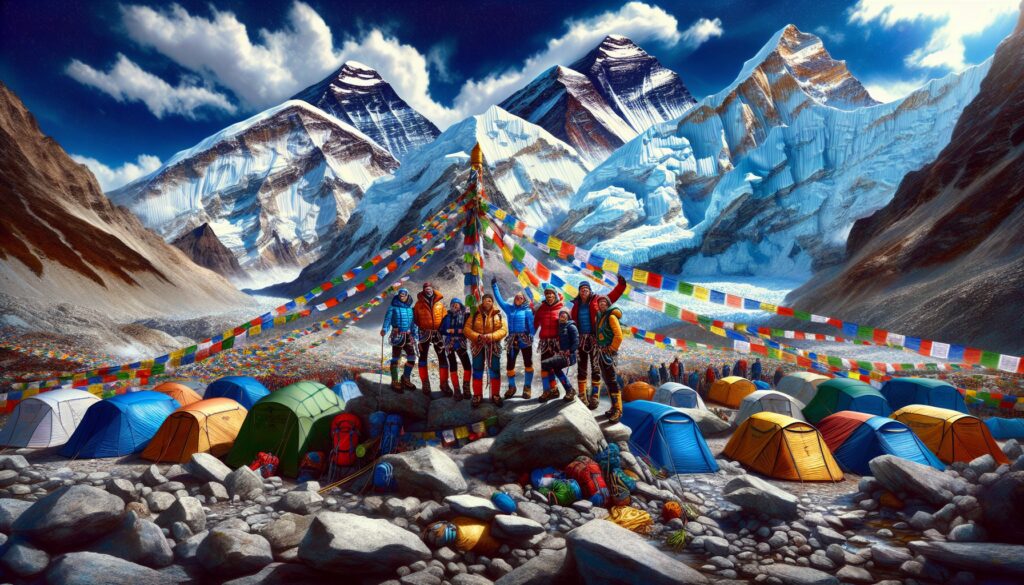
Embarking on an expedition to the foot of the world's highest peak is a dream for many adventurers. The Everest Base Camp trek is an iconic journey that offers breathtaking landscapes, unique cultural experiences, and the ultimate challenge for trekkers.
Preparing to tackle this formidable trek requires careful planning and determination. As you read on, you'll discover essential insights and tips that will guide you on your journey to one of Earth's most revered destinations.
🔍 Seeking a breakthrough in Type 2 Diabetes management?
Discover our expert insights and innovative approaches on ‘How to Cure Diabetes’.
Click to transform your health journey today!
What you\'ll find in this article?
- What is Everest Base Camp?
- Where is the South Base Camp Located?
- What are the key highlights of the Everest Base Camp trek?
- How do I prepare for the Everest Base Camp trek?
- What is the best time to trek to Everest Base Camp?
- What are the costs involved in the Everest Base Camp trek?
- What are the essential gear and packing list for Everest Base Camp?
- Preguntas relacionadas sobre trekking to Everest Base Camp
What is Everest Base Camp?
The term Everest Base Camp refers to two primary camps located at the base of Mount Everest. These are crucial starting points for climbers aiming to reach the summit. Here, trekkers can experience the majesty of the Himalayas without the technical climb to the peak.
The South Base Camp in Nepal is the more frequented of the two, allowing trekkers to immerse themselves in the stunning vistas and Sherpa culture. It's not just a point on the map; it's a symbol of human endurance and the spirit of exploration.
The journey to Base Camp is as rewarding as it is challenging, presenting trekkers with a path that meanders through rugged trails, serene monasteries, and the warm hospitality of mountain communities.

Explore our specialized services in diabetes care 🌟.
From personalized diet plans to effective exercise routines, we have what you need to take control of Type 2 Diabetes.
Visit our services page now!
Where is the South Base Camp Located?
Nestled in the heart of the Himalayas, the South Base Camp lies in Nepal at an elevation of 5,364 meters. It is the more accessible of the two camps and serves as a hub for trekkers and climbers alike.
Starting from a thrilling flight to Lukla, the trek to Everest Base Camp winds through ancient trails that have connected mountain villages for centuries. This journey is not just about reaching a destination, but also about witnessing the evolving landscape and the enduring spirit of the Nepalese people.
Despite the challenges posed by altitude and terrain, the South Base Camp remains an attainable goal for those willing to embrace the adventure and understand the significance of this high-altitude haven.
What are the key highlights of the Everest Base Camp trek?
As you embark on your journey to Everest Base Camp, each day unfolds with new highlights that make this trek an unforgettable experience.
- The scenic flight to Lukla is your thrilling gateway to the Everest region, offering stunning aerial views of the Himalayas.
- Namche Bazaar, the bustling Sherpa capital, is a cultural hub where trekkers can mingle with locals and soak in breathtaking mountain panoramas.
- Acclimatization hikes to places like Dingboche provide glimpses into the life above the tree line and the adaptations of high-altitude communities.
- The Tengboche Monastery, an important spiritual center, allows trekkers to experience the tranquility and devotion that permeates the region.
- Finally, the arrival at Everest Base Camp itself is a triumph of the human spirit, offering a sense of accomplishment and awe as you stand at the foot of the mighty Everest.
How do I prepare for the Everest Base Camp trek?
Preparation for the Everest Base Camp trek is critical for a successful and enjoyable experience. Adequate physical training, gear selection, and mental readiness are just the beginning.
Devise a fitness plan months in advance that includes cardiovascular exercises, strength training, and hiking to condition your body for the strenuous journey.
Researching the trek, understanding the risks involved, and knowing the signs of altitude sickness can go a long way in ensuring your safety and enjoyment on the trail.
Gathering the right gear is also essential. Investing in quality clothing, footwear, and equipment will protect you from the elements and enhance your trekking experience.
Lastly, patience and determination are your best allies. The trek is as much a mental challenge as it is physical, and a positive mindset will carry you through the tough times.
What is the best time to trek to Everest Base Camp?
Timing your trek correctly can be the difference between an enjoyable journey and a challenging ordeal. The best times to trek to Everest Base Camp are during the pre-monsoon spring months of April and May, and the post-monsoon autumn period from September to November.
Spring welcomes trekkers with blooming rhododendrons and clearer skies, while autumn promises stable weather and excellent visibility.
Although these seasons are popular among trekkers, it's essential to book accommodations and flights early to secure your spot on the trail.
What are the costs involved in the Everest Base Camp trek?
The costs of hiking to Everest Base Camp can vary significantly depending on the choices you make, such as the trekking agency, the level of comfort you desire, and any additional tours or services.
Basic expenses include permits, flights to and from Lukla, accommodation, food, and guide and porter services. It's prudent to budget for unforeseen expenses and tips for your support team.
Investing in travel insurance for the Everest Base Camp trek is also highly recommended, as it covers unexpected emergencies and evacuations.
What are the essential gear and packing list for Everest Base Camp?
Packing for the Everest Base Camp trek requires a careful balance between necessity and weight. Essential gear includes:
- Durable, warm clothing that can be layered to cope with the fluctuating temperatures.
- A sturdy backpack with a comfortable harness system.
- Quality hiking boots that are broken in and comfortable.
- Sleeping bag suitable for sub-zero temperatures.
- Navigation tools, such as a map and compass or a GPS device.
- First aid kit with altitude sickness medication and personal hygiene items.
Remember to pack light and smart, focusing on multi-use items and leaving non-essential gadgets at home.
Preguntas relacionadas sobre trekking to Everest Base Camp
How hard is it to get to Everest Camp 1?
Reaching Everest Camp 1 is a formidable task that requires physical fitness, mental fortitude, and careful acclimatization. It is considered challenging due to the altitude, steep climbs, and unpredictable weather.
However, with the right preparation, guidance, and determination, it is an achievable goal for many. The journey rewards trekkers with an unparalleled sense of achievement and breathtaking views of the Himalayan giants.
How much does Everest Base Camp 1 cost?
The cost for an Everest Base Camp trek can range broadly depending on various factors such as the duration of the trek, the level of luxury, and whether you choose a guided or independent trek.
A budget trek may cost anywhere from $1,000 to $2,500, while a more inclusive package with a reputable company could be upwards of $3,500. It's important to factor in additional expenses like tips, snacks, and extra tours.
How high is base camp 1 on Everest?
Everest Base Camp, often referred to as Camp 1, sits at an elevation of approximately 5,364 meters (17,598 feet) above sea level on the south side in Nepal.
This elevation makes it higher than most mountains around the world and presents a significant challenge due to the reduced oxygen levels.
What is the failure rate of Everest Base Camp?
The failure rate for reaching the Everest Base Camp varies, with estimates suggesting that roughly 10% of trekkers do not complete the trek.
Common reasons for not reaching the base camp can range from altitude sickness to personal health issues or unfavorable weather conditions. Proper preparation and acclimatization are key to increasing the chances of a successful trek.
✨ Other articles you might be interested in:
- Maximizing results: Weekly weigh in - Fridays for consistent tracking
- Unveiling how exercise hormone irisin aids calorie burn through brown fat
- Banish Insomnia -- Sleep Safe With Amino Acids
- 24 Hours Fitness Center: Freeing You from the Stress Brought by Time
- 24 Hour Fitness Centers and Clubs: Providing You with a Healthy and Fit Body



